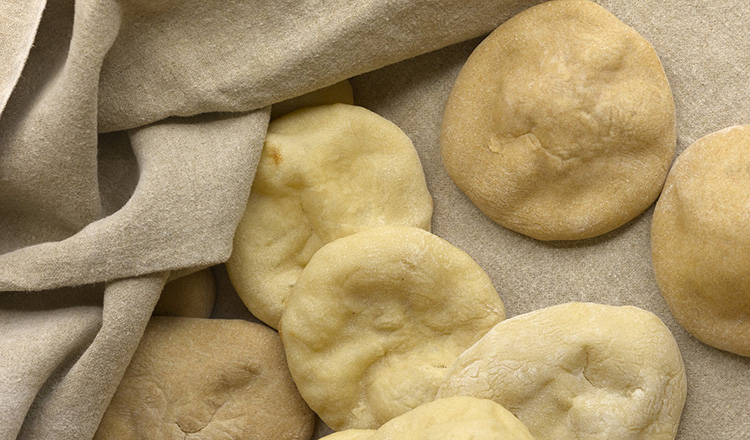Making homemade pita is fun and satisfying, since there isn’t much better than a warm, fresh piece of bread! This recipe uses a Poolish, which is a style of pre-ferment that helps create flavor in the finished dough. This bit of dough will be pretty dense and may feel dry, but that’s what it’s supposed to be, so don’t get worried.
Makes 14 pieces
Poolish
Ingredients
- 3/4 cup water, 55°F
- 1 1/3 cups bread flour
- 1/2 teaspoon instant dry yeast
Final Dough
Ingredients
- Poolish
- 1 1/2 cups water, 95°F
- 3 tablespoons vegetable oil
- 1 teaspoon honey or malt syrup
- 4 1/3 cups bread flour
- 1 teaspoon instant dry yeast
- 1 tablespoon kosher salt
Directions
- Prepare the poolish the day before you want to serve the pita. Combine the water, flour and yeast in a bowl and mix together by hand until homogenous. You will still have little lumps and the poolish will be very wet, looser than a dough. Cover the polish with plastic wrap and refrigerate for 2 hours. Remove and leave at room temperature for 10 to 12 hours. At this point, the polish will have fermented and will have bubbles visible on its surface.
- To make the final dough, put the poolish in the bowl of a mixer with the water, oil, and honey. Combine the flour with the yeast, then add them to the bowl. Add the salt and place the bowl on a mixer fitted with a dough hook. Mix for 4 minutes on low speed, making sure to scrape down the bowl and flip the dough over twice during the mixing time. Then mix for 3 minutes on medium speed, making sure to scrape down the bowl and flip the dough over. At this point, the dough will still feel tacky but will have full gluten development. Place the dough in a lightly oiled bowl large enough for it to double in size and cover with plastic wrap.
- Allow the dough to rest and ferment in a warm place for 60 to 75 minutes, until when lightly touched the dough springs back halfway.
- Place the dough on a lightly floured work surface and divide it into fourteen 3-oz pieces. Cover the dough pieces with plastic wrap and allow them to rest and ferment in a warm place for 15 minutes, until when lightly touched the dough springs back halfway.
- Lightly flour each dough piece and roll it out to a circle about 5 1/2 inches in diameter. Place each piece on a tray and cover with a lightly floured cloth. After rolling all the pieces, cover them lightly with plastic wrap. Allow the covered dough to rest and ferment in a warm place for 20 to 25 minutes, until when lightly touched the dough springs back halfway.
- Preheat the oven to 500°F with a baking stone.
- Using a piece of stiff cardboard or the back of a cookie sheet, transfer the pieces to a floured peel 1 at a time, then transfer them onto the baking stone. (You will not be able to bake all the pieces at once.) Bake the pieces for 3 to 4 minutes, until they puff up but brown very little.
- Remove the bread from the oven and place the pieces in a folded kitchen towel to cover them, help retain the moisture, and keep them from drying out.
- Allow the stone to reheat for 10 minutes, then continue baking the remainder of the pitas. Once the pitas are completely cool, they may be tightly wrapped and kept at room temperature, if they are not eaten immediately.


